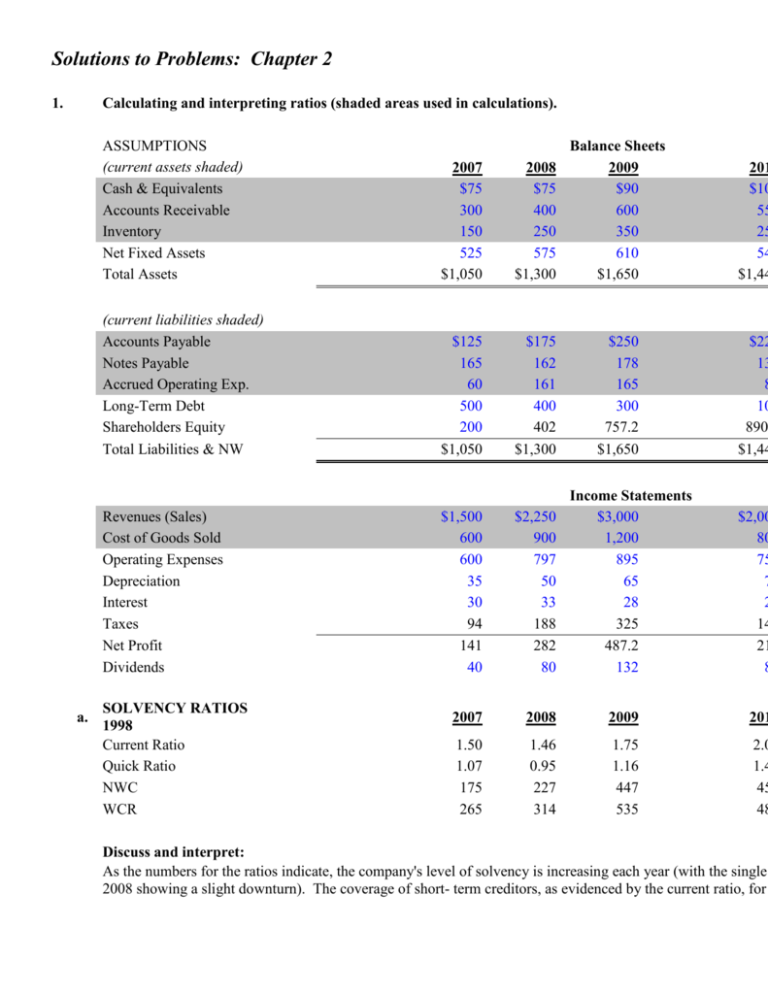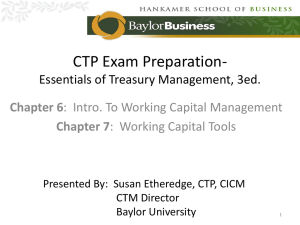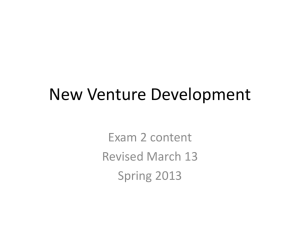Chap2
advertisement

Solutions to Problems: Chapter 2
1.
Calculating and interpreting ratios (shaded areas used in calculations).
ASSUMPTIONS
(current assets shaded)
Cash & Equivalents
Accounts Receivable
Inventory
Net Fixed Assets
Total Assets
2007
$75
300
150
525
$1,050
(current liabilities shaded)
Accounts Payable
Notes Payable
Accrued Operating Exp.
Long-Term Debt
Shareholders Equity
Total Liabilities & NW
$125
165
60
500
200
$1,050
Revenues (Sales)
Cost of Goods Sold
Operating Expenses
Depreciation
Interest
Taxes
Net Profit
Dividends
a.
SOLVENCY RATIOS
1998
Current Ratio
Quick Ratio
NWC
WCR
2008
$75
400
250
575
$1,300
Balance Sheets
2009
$90
600
350
610
$1,650
201
$10
55
25
54
$1,44
$175
162
161
400
402
$1,300
$250
178
165
300
757.2
$1,650
$22
13
8
10
890
$1,44
Income Statements
$3,000
1,200
895
65
28
325
487.2
132
$1,500
600
600
35
30
94
141
40
$2,250
900
797
50
33
188
282
80
$2,00
80
75
7
2
14
21
8
2007
2008
2009
201
1.50
1.07
175
265
1.46
0.95
227
314
1.75
1.16
447
535
2.0
1.4
45
48
Discuss and interpret:
As the numbers for the ratios indicate, the company's level of solvency is increasing each year (with the single
2008 showing a slight downturn). The coverage of short- term creditors, as evidenced by the current ratio, for
increases from $1.50 of current assets per dollar of current liabilities in 2007 to $2.27 of current assets for ever
current liabilities in 2011.
b. Calculating the cash conversion period.
Days Sales Outstanding = Receivables / (Sales / 365)
Days Inventory Held = Inventory / (COGS / 365)
Days Payable Outstanding = Payables / (COGS / 365) *
Purchases = Ending inventory - Beginning inventory + Cost of Goods Sold
Operating Cycle = Days Sales Outstanding + Days Inventory Held
Cash Conversion Period = Operating Cycle - Days Payable Outstanding
Days Sales Outstanding
Days Inventory Held
Days Payables Out
Operating Cycle
Cash Conversion Period
NA
2007
73.00
91.25
76.04
164.25
2008
64.89
101.39
70.97
166.28
2009
73.00
106.46
76.04
179.46
201
100.3
114.0
102.6
214.4
88.21
95.31
103.42
111.7
Interpret the 4-year trend:
The cash conversion period shows an increasing Trend over the five-year period. Although the firm’s solvency
over the period in question (see part a), the firm becomes more liquid (as evidenced by the longer CCPs).
2. a. The repayment of $50,000 in trade credit with cash will not change the current ratio if the initial current ratio is
illustrate, assume that the initial levels of current assets and liabilities equal $200,000 apiece. The transaction r
above implies that the new current ratio equals 1.00 ([200,000-50,000]/[200,000-50,000]).
b. An intial current ratio of 0.50 implies initial current assets of $200,000 and current liabilities of $400,000. Thu
repayment of trade credit will reduce the current ratio to 0.43 ([200,000-50,000]/[400,000-50,000]).
c.
3.
In this case the current ratio will increase. An intial current ratio of 1.70 implies initial current assets of $340,0
liabilities of $200,000. Thus, the repayment of trade credit will increase the current ratio to 1.93 ([340,000-50,
50,000]).
Current DSO =
Desired DSO =
Revenue =
Borrowing rate =
35
30
10,000,000
2.5%
days
days
Next year's DIH =
Next years's DPO =
45
75
days
days
$958,904
a. The given data suggests that the current level of A/R is
to 30 days without a reduction in revenues suggests that receivables will drop to
This implies that reducing the DSO will result in a
$136,986
b. Financing cost reduction =
c.
Hence, reducing the
lower investment in
$3,424.66
75 days
0 days
The new OC equals
The new CCP equals
OC = DSO + DIH
CCP = OC - DPO
4. Central Mississippi Devices -- considering a cash discount.
DATA FOR CURRENT TERMS:
prompt payors
percent of total customers
average payment day
average invoice amount
80%
35
$4,000
laggards
percent of total customers
average payment day
average invoice amount
annual cost of capital
a. Cashflow timeline under current terms.
Avg Prompt Payor Day =
35
---|------------------------------------------------|------------------------------|------------->
Avg Invoice =
(0.8)($4K)
Day 0
$3,200
Avg Laggard Day =
Avg Invoice = (0.2)
$800
PV = $3,200 x 1 / [1 + (0 .11/365) x 35]
=
$3,166.60
PV = $800 x 1 / [1 + (0.11/365) x 72]
=
$783.01
Total PV of Current Terms = $3,166.60 + $783.01 =
$3,949.6
b. Cashflow timeline under proposed 2/10, net 30 terms
DATA FOR PROPOSED TERMS:
prompt payors
laggards
percent of total customers
payment day, discounting
payment day, non discounting
average invoice amount
percent discount
percent to take discount
80.00%
10
40
$4,000
2.00%
50.00%
Day 0
percent of total customers
payment day, discounting
payment day, non discounting
average invoice amount
percent discount
percent to take discount
annual cost of capital
Day 40
Day 10
Da
80
--|--------------------------------------|---------------------------|------------------|-------->
40% x 0.98 x $4K / day
40% x $4K / day 16% x $4K
+ 4% x .98 x $4K / day
$1,724.80
$1,600.00
PV = $1,724.80{ 1 / [1 + ( .11/365)(10)]}|
PV
$1,719.62
PV = $1,600{ 1 / [1 + (.11/365)(40)]}
PV
$1,580.94
FV = $640
PV = $640{ 1 / [1 + (.11/365)(80)]}
PV
$624.93
Total PV of Proposed Terms =
$1,719.62
+
=
c.
$1,580.94
+
$3,925.49 per day
Net Present Value of Proposal = $3,925.49 - $3,949.61 =
So, if the forecasts are correct, on an average invoice the firm will lose $24.12
per day from the proposed change.
d. Other factors to take into account are industry practice, any other direct costs for this
product line, marketing aspects, company or competitor promotions going on or
anticipated in the future, and the company's overall strategy.
e.
$624.93
By varying the percentage of discount takers, we can observe the change in NPV of the
proposed change. The analysis is valuable in this case, showing that even with no cash
discount takers, the proposal is a loser. In other words, there is no "prompt payor" cash
discount utilization rate which would make this project a winner on an NPV basis.
Here are the sensitivity analysis results:
($24.12
% Cash Discount
Takers (Prompt Payors)
0%
30%
40%
base case
50%
60%
70%
NPV per average invoice
($6.46)
($17.05)
($20.59)
($24.12)
($27.65)
($31.18)









